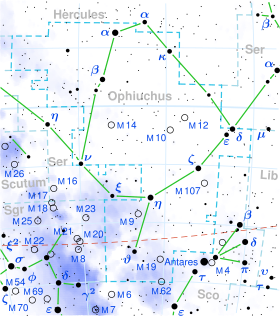45 Ophiuchi
| Observation data Epoch J2000 Equinox J2000 | |
|---|---|
| Constellation | Ophiuchus |
| Right ascension | 17h 27m 21.27571s[1] |
| Declination | −29° 52′ 01.3262″[1] |
| Apparent magnitude (V) | 4.28[2] |
| Characteristics | |
| Spectral type | F5III-IV[3] |
| U−B color index | +0.11[4] |
| B−V color index | +0.40[4] |
| Astrometry | |
| Radial velocity (Rv) | +38.00[5] km/s |
| Proper motion (μ) | RA: +17.08[1] mas/yr Dec.: -138.02[1] mas/yr |
| Parallax (π) | 29.23 ± 0.20 mas[1] |
| Distance | 111.6 ± 0.8 ly (34.2 ± 0.2 pc) |
| Absolute magnitude (MV) | 1.61[2] |
| Details | |
| Mass | 1.71[6] M☉ |
| Radius | 3.2[6] R☉ |
| Luminosity | 19.07[2] L☉ |
| Surface gravity (log g) | 3.67[6] cgs |
| Temperature | 6,750[7] K |
| Metallicity [Fe/H] | +0.10[7] dex |
| Rotational velocity (v sin i) | 65.4[8] km/s |
| Age | 1.24±0.18[7] Gyr |
| Other designations | |
| Database references | |
| SIMBAD | data |
45 Ophiuchi is a single[10] star in the equatorial constellation of Ophiuchus, along the southern border with Scorpius. It has the Bayer designation d Ophiuchi, while 45 Ophiuchi is the Flamsteed designation. In the past it had the designation Theta Telescopii.[11] This object is visible to the naked eye as a faint, yellow-white hued star with an apparent visual magnitude of 4.28.[2] It is located approximately 111.6 light years away from the Sun based on parallax.[1] The star is drifting further from the Earth with a heliocentric radial velocity of +38 km/s.[5]
This object has a stellar classification of F5III-IV,[3] matching an F-type star with a luminosity class displaying mixed traits of a subgiant and a giant star. It is 1.2[7] billion years old with 1.7[6] times the mass of the Sun and 3.2[6] times the Sun's radius. The star is radiating 19[2] times the luminosity of the Sun from its photosphere at an effective temperature of 6,750 K.[7] It is spinning with a projected rotational velocity of 65 km/s.[8]
References
- ^ a b c d e f Van Leeuwen, F. (2007). "Validation of the new Hipparcos reduction". Astronomy and Astrophysics. 474 (2): 653. arXiv:0708.1752. Bibcode:2007A&A...474..653V. doi:10.1051/0004-6361:20078357. Vizier catalog entry
- ^ a b c d e Anderson, E.; Francis, Ch. (2012). "XHIP: An extended hipparcos compilation". Astronomy Letters. 38 (5): 331. arXiv:1108.4971. Bibcode:2012AstL...38..331A. doi:10.1134/S1063773712050015. Vizier catalog entry
- ^ a b Gray, R. O.; Corbally, C. J.; Garrison, R. F.; McFadden, M. T.; Bubar, E. J.; McGahee, C. E.; O'Donoghue, A. A.; Knox, E. R. (2006). "Contributions to the Nearby Stars (NStars) Project: Spectroscopy of Stars Earlier than M0 within 40 pc--The Southern Sample". The Astronomical Journal. 132: 161. arXiv:astro-ph/0603770. Bibcode:2006AJ....132..161G. doi:10.1086/504637.
- ^ a b Mermilliod, J. C. (2006). "VizieR Online Data Catalog: Homogeneous Means in the UBV System (Mermilliod 1991)". VizieR On-line Data Catalog: II/168. Originally Published in: Institut d'Astronomie. 2168. Bibcode:2006yCat.2168....0M.Vizier catalog entry
- ^ a b Gontcharov, G. A. (2006). "Pulkovo Compilation of Radial Velocities for 35 495 Hipparcos stars in a common system". Astronomy Letters. 32 (11): 759. arXiv:1606.08053. Bibcode:2006AstL...32..759G. doi:10.1134/S1063773706110065.
- ^ a b c d e Allende Prieto, C.; Lambert, D. L. (1999). "Fundamental parameters of nearby stars from the comparison with evolutionary calculations: Masses, radii and effective temperatures". Astronomy and Astrophysics. 352: 555. arXiv:astro-ph/9911002. Bibcode:1999A&A...352..555A. Vizier catalog entry
- ^ a b c d e Pace, G. (March 2013). "Chromospheric activity as age indicator. An L-shaped chromospheric-activity versus age diagram". Astronomy & Astrophysics. 551: 4. arXiv:1301.5651. Bibcode:2013A&A...551L...8P. doi:10.1051/0004-6361/201220364. L8.
- ^ a b De Medeiros, J. R.; Alves, S.; Udry, S.; Andersen, J.; Nordström, B.; Mayor, M. (2014). "A catalog of rotational and radial velocities for evolved stars". Astronomy & Astrophysics. 561: A126. arXiv:1312.3474. Bibcode:2014A&A...561A.126D. doi:10.1051/0004-6361/201220762. Vizier catalog entry
- ^ "d Oph". SIMBAD. Centre de données astronomiques de Strasbourg. Retrieved 2019-06-22.
- ^ Eggleton, P. P.; Tokovinin, A. A. (September 2008). "A catalogue of multiplicity among bright stellar systems". Monthly Notices of the Royal Astronomical Society. 389 (2): 869–879. arXiv:0806.2878. Bibcode:2008MNRAS.389..869E. doi:10.1111/j.1365-2966.2008.13596.x.
{{cite journal}}: CS1 maint: unflagged free DOI (link) - ^ Ian Ridpath. "Telescopium - The Telescope". Ian Ridpath's Star Tales. Retrieved 2019-06-23.

